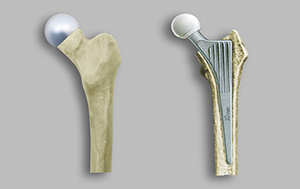Hip resurfacing is a type of hip replacement surgery designed to alleviate hip pain and stiffness resulting from conditions like osteoarthritis. This procedure involves the use of implants to replace damaged tissue and bone in the hip, enabling smoother and more fluid movement. Typically, it is recommended for men under the age of 60 who are considered ideal candidates for hip resurfacing.
What is hip resurfacing?
Hip resurfacing is a surgical procedure that involves replacing the damaged surface of the hip joint with a metal implant. It is primarily used to relieve hip pain and improve hip joint function in individuals with conditions like osteoarthritis. Unlike traditional hip replacement, in hip resurfacing, more of the patient's natural bone is preserved, as only the surface of the joint is replaced. This procedure is often recommended for younger patients with good bone quality and is considered an alternative to traditional hip replacement for certain candidates.

FAQs
Almost all resurfacings are metal-on-metal devices, both sides of which are made from an alloy known as cobalt-chromium-molybdenum. There is, however, at least one device that has a metal-on-plastic bearing. Currently, there is no ceramic hip resurfacing available, but several companies and research institutions are working on their development.
Typically, a patient who has had a hip resurfacing will be in hospital for 2 to 3 days.
The typical follow-up regimen is 2 weeks, 6 weeks, 3 months, 6 months, 1 year, and then annually thereafter. Patients who do not live close by may follow up with a medical professional in their area, but should check with their office beforehand.
The recovery period following Hip Resurfacing surgery will vary depending on the patient. In general, the orthopedic surgeon will encourage the patient to use the new joint soon after the operation. Usually, the patient will be standing and beginning to walk within several days. The patient will normally use crutches or a cane for a period of time. The patient will also learn to do appropriate exercises to move and strengthen the joint.
Both ice and heat can be used to help relieve pain but both can be harmful if left on too long. Never sleep with a heating pad on your hip. It can damage the skin and even cause a severe burn. Ice can be used several times a day. 20 minutes on, 20 minutes off, is the usual regime.
Driving is an individual matter. Some people regain their coordination and reflexes quickly and others take longer. Following hip surgery, you should avoid driving for at least 2-3 weeks, depending on your progress.
With the development of Birmingham's hip resurfacing surgery, many advantages exist for hip resurfacing surgery compared to the traditional full hip replacement.
Smaller Device: Birmingham device is chrome cobalt, metal combination. It is smaller than a traditional total hip device. With a smaller device, the recovery is quicker.
Reduction in the Bone removed: Birmingham hip resurfacing literally means retreading the bone with a metal prosthesis. Therefore, there is a significant decrease in the amount of bone removed. Only a very small amount of bone needs to be removed. The femur (thigh) bone does not need to be damaged.
Decrease in Complication Rates: Birmingham hip surgery greatly reduces the disruption of the joint, therefore providing a shorter recovery period and a decrease in some complications. There is a dramatic reduction in dislocation rates and a reduction in the problem of lengthening or shortening the leg.
Shorter Recovery Time: Most Birmingham hip patients are walking 4 hours after surgery. Total time spent in hospital is approximately 2 days. Within 2 weeks, most patients are back driving, resuming most of their normal activities. Birmingham hip resurfacing dramatically improves the quality of life. For total hip replacement, most people remain in the hospital for 5-6 days and remain off driving for 6 weeks.
More stable hip: Because hip replacements use a smaller ball (to allow thicker plastic for longer wear) the range of movement is less and the dislocation rate greater (up to 1 in a 25) than a BHR. The hip resurfacing has a dislocation rate of less than 1 in 500 because the ball is not removed and remains the same size as the patient’s original hip. The range of movement is greater. Because the hip is more stable and feels more normal, the recovery is quicker and the function is generally better.
Ease of Revision: Because hip resurfacing does not damage the thigh bone, when they fail they can be more easily converted to a total hip replacement. This is important in young patients who wear out total hip replacements because it saves this procedure as a later option when they are older.
During the first days after surgery, you should learn to walk stairs with a physiotherapist at the hospital. The pace at which you regain agility on stairs depends on individual traits.
CONSULT AIOR FOR ORTHOPAEDICS PROBLEMS
Call Now 0612-2368881, +91-9931306306 and receive Top Quality Healthcare for you and your Family

